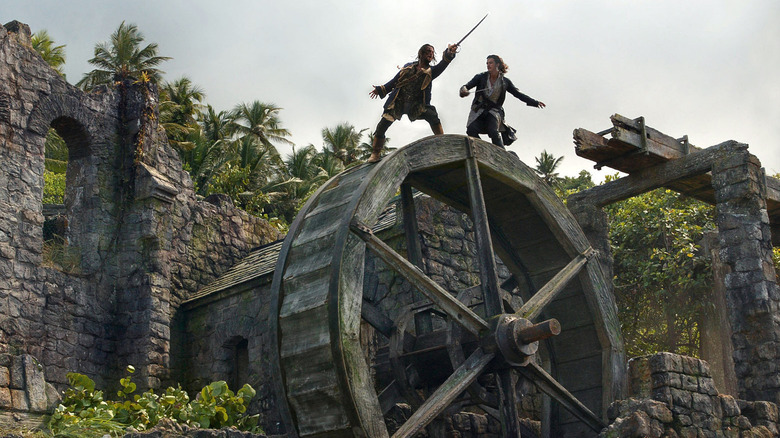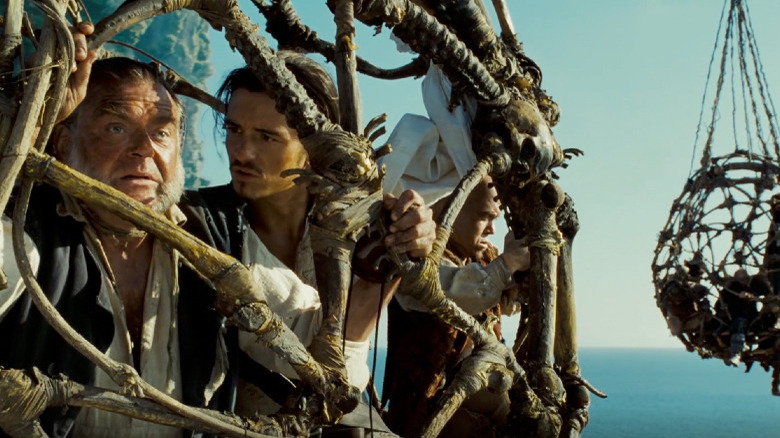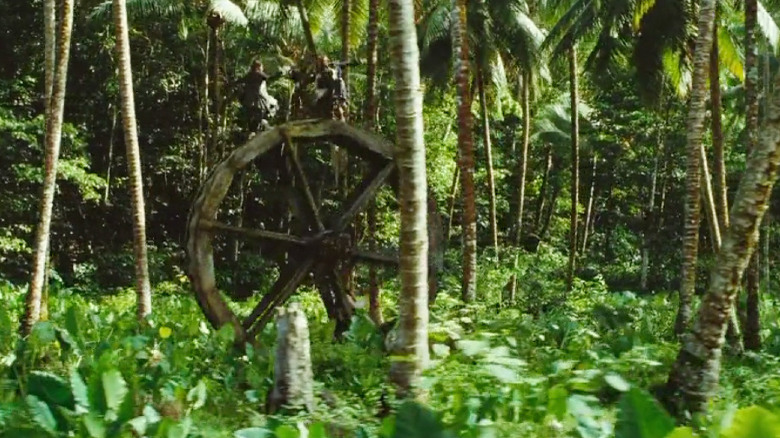Two Set Pieces Caused Major Trouble For The Pirates Of The Caribbean Trilogy
Say what you will about Gore Verbinski's "Pirates of the Caribbean" trilogy, but one cannot accuse the director of phoning things in (not in good faith, anyway). The first of the "Pirates" films, "The Curse of the Black Pearl" in 2003, was a grand ol' time, deftly wedding an old-school swashbuckler with elements from the famed Disney theme park ride and a wry sense of wit provided by "Aladdin" and "Shrek" co-writers Ted Elliott and Terry Rossio. Over $654 million later, Elliott, Rossio, and Verbinski reunited to shoot a pair of back-to-back sequels in the hopes of bottling lightning two more times. The results, put plainly, are a lot, but again, the opposite of phoning things in.
Of the two "Pirates of the Caribbean" sequels, it's 2006's "Dead Man's Chest" that presented some of the biggest technical challenges. The movie features two of the more inspired set pieces in the entire franchise, both of which involve actors being tossed about in giant circular objects rolling down hills (one of them a cage made out of human bones, the other a mill wheel). As you might imagine, it was one thing for Verbinski to commit to these ideas, but actually executing them proved to be far more difficult.
The cannibal run
The first of these set pieces takes place on an island where a tribe of cannibals have taken the crew of the Black Pearl captive, forcing them to escape in a cage built from the bones of the locals' previous victims. It's a turn of events blending macabre subject matter with broad slapstick, a core aspect of Verbinski's work going back to his directing debut on 1997's "Mouse Hunt" (a film that, frankly, does a better job embodying Verbinski's artistic impulses than his first real breakout hit, "The Ring").
"You draw this stuff on a napkin at lunch and then you do storyboards or thumbnails and you try to explain it to the producers and the crew and they look at you like you're insane," as the director told IGN in 2006. Further complicating matters, the sequence begins with the crew of the Black Pearl dangling in one of these bone cages over a high gorge (a place where one wrong move could send them plummeting to their death).
Verbinski broke down the intricacies of planning out this set piece for IGN:
"In the bone cage, they had a scene where they were in these cages and they were on land and they escaped from the bone cages. Working with my good friend Jim Burkett, who's sort of my storyboard artist and compatriot and ally in this madness, we would spend a lot of time just thinking [things like], 'Why do they have to leave the cage? Why don't they escape and have to carry the cages with them. They can't get out.' And that's when we came up with the hanging and then swinging, and they don't get out, and they have to pick them up and run with them and they roll them."
Wheel of fortune
Bear in mind, these twisted set pieces didn't just spring forth from Verbinski's mind. In fact, the other most noteworthy one in "Dead Man's Chest" — a three-way sword fight between Will Turner (Orlando Bloom), Jack Sparrow (Johnny Depp), and James Norrington (Jack Davenport) on a runaway mill wheel — was pitched by Elliott and Rossio. "The fun part is, the writers would say, 'And then the three-way sword fight starts, and it's an amazing three-way sword fight. It's kind of like 'Rome burns.' They don't describe the action," Verbinski noted.
By the time they were making "Dead Man's Chest," Verbinski's writers had come to trust he would find a way to make whatever zany concepts they cooked up a reality. In the case of this sword fight, he was quite happy to shake things up, too. Verbinski explained:
"Sword fights are sort of inherently boring and I don't know how to make a sword fight better than a sword fight I've seen in 100 other movies. But when you put it on a wheel...you can riff on the whole thing... And then it's really about stepping it [up] and evolving it and building the action so it escalates."
Verbinski's commitment to keeping things practical as much as possible is a big part of what makes these set pieces so great. But by the same count, it also made them a pain in the butt to film. "Physically shooting that stuff was probably the most difficult because it's all shot-specific," shared Verbinski, explaining that it required 180-foot cranes, as well as ensuring the actors' safety while subjecting them to all manner of physical torment. "It was like the vomit ride," he added.
No doubt, those set pieces were uncomfortable to shoot. But watching them? That's a whole other story.


